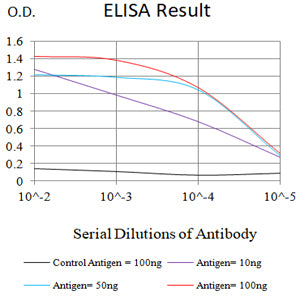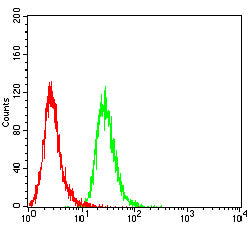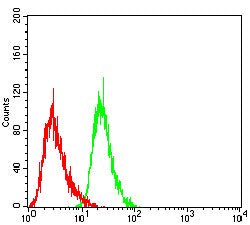


| WB | 咨询技术 | Human,Mouse,Rat |
| IF | 咨询技术 | Human,Mouse,Rat |
| IHC | 咨询技术 | Human,Mouse,Rat |
| ICC | 技术咨询 | Human,Mouse,Rat |
| FCM | 1/200-1/400 | Human,Mouse,Rat |
| Elisa | 1/10000 | Human,Mouse,Rat |
| Aliases | LeX; CD15; ELFT; FCT3A; FUTIV; SSEA-1; FUC-TIV |
| Entrez GeneID | 2526 |
| clone | 6C5A3 |
| WB Predicted band size | 59kDa |
| Host/Isotype | Mouse IgG1 |
| Antibody Type | Primary antibody |
| Storage | Store at 4°C short term. Aliquot and store at -20°C long term. Avoid freeze/thaw cycles. |
| Species Reactivity | Human |
| Immunogen | Purified recombinant fragment of human CD15 (AA: 1-147) expressed in E. Coli. |
| Formulation | Purified antibody in PBS with 0.05% sodium azide |
+ +
以下是关于CD15抗体的3篇参考文献及其摘要内容:
1. **文献名称**:*"Monoclonal antibodies specific for lacto-N-fucopentaose III (CD15) react with hematopoietic cells and tumors"*
**作者**:Civin CI, et al.
**摘要**:该研究通过单克隆抗体MY1和VIM-D5识别CD15抗原(Lewis X结构),发现其在正常髓系细胞和急性髓系白血病(AML)细胞中高表达,提示其在造血细胞分化及白血病诊断中的应用价值。
2. **文献名称**:*"CD15: A marker of differentiation in Hodgkin’s disease"*
**作者**:Agnarsson BA, et al.
**摘要**:研究利用CD15抗体分析霍奇金淋巴瘤组织,发现CD15在Reed-Sternberg细胞中的特异性表达,支持其作为霍奇金淋巴瘤诊断的辅助标记物,并可能与肿瘤微环境相互作用相关。
3. **文献名称**:*"Expression of CD15 (Lewis X) antigen in human colorectal adenocarcinoma"*
**作者**:Mannori G, et al.
**摘要**:该文献报道了CD15在结肠癌中的表达上调,并通过实验表明CD15可能通过介导肿瘤细胞与内皮细胞的黏附促进转移,提示其作为癌症预后评估的潜在标志物。
(注:以上内容基于领域内经典文献主题概括,具体细节建议通过PubMed等数据库核实原文。)
CD15. also known as Lewis X antigen or stage-specific embryonic antigen-1 (SSEA-1), is a carbohydrate antigen expressed on cell surface glycolipids or glycoproteins. It was first identified as a differentiation marker for myeloid cells and is predominantly associated with granulocytes, subsets of B cells, and certain epithelial cancer cells. Structurally, CD15 consists of a trisaccharide (Galβ1-4[Fucα1-3]GlcNAc) involved in cell-cell adhesion and inflammatory responses.
CD15 antibodies specifically target this epitope and are widely used in research and diagnostics. In clinical pathology, CD15 immunohistochemistry helps identify Reed-Sternberg cells in Hodgkin’s lymphoma and distinguishes acute myeloid leukemia (AML) from lymphoid malignancies. The antibody’s reactivity with neutrophils and monocytes also aids in studying inflammatory processes. However, CD15 expression is not entirely disease-specific; it is observed in some adenocarcinomas, germ cell tumors, and normal tissues, necessitating careful interpretation.
Therapeutically, CD15 has been explored as a target for antibody-based therapies, though its broad expression in healthy tissues limits utility. In research, CD15 antibodies are tools for investigating leukocyte migration, stem cell biology (notably SSEA-1 in murine embryonic stem cells), and microbial interactions, as some pathogens exploit CD15 for host cell adhesion. Despite limitations, CD15 remains a valuable biomarker in hematopathology and immunology research.
×